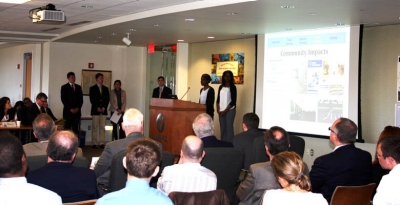Senior Project Leads to Industry Presentation

Kimberley Musey ’15 CE and Lia Fabian ’15 CE represent their senior capstone design team in a presentation of “National Highway System Connector Evaluations” at a meeting of the Delaware Valley Regional Planning Commission’s Goods Movement Task Force.
For their senior capstone, a group of 11 Civil and Environmental Engineering students took on a real-world transportation project with Assistant Professor Leslie McCarthy, PhD, PE. Sponsored by the Delaware Valley Regional Planning Commission’s (DVRPC) Office of Freight and Aviation Planning, “Designing Upgrades of the National Highway System Connectors to Intermodal Freight Facilities in the Philadelphia Area” provided the students with professional experience that included a formal presentation to the DVRPC’s Goods Movement Task Force.
“Changes in the energy marketplace are having a significant bearing on regional transportation systems,” explains Dr. McCarthy. As the U.S. lessens its dependence on foreign oil, and grows its domestic energy output, the Mid-Atlantic states, and the Philadelphia region in particular, are feeling the effects, both positive and negative. Regional rail lines and Delaware River ports are supporting increasing amounts of freight, which then impacts the National Highway System (NHS) connectors— defined by the Federal Highway Administration (FHWA) as the public roads leading to major intermodal terminals. NHS connectors are often only two-lane roads which account for less than 1 percent of total NHS mileage. Not all of the key routes needed for the timely and reliable delivery of goods are in adequate condition to handle the increased demands and many of them cross through neighborhoods that suffer from socioeconomic and environmental justice issues.
For this project, Dr. McCarthy’s team focused on the connectors and neighboring interstate highways most in need of upgrades to support three key ports in the region: Tioga Marine Terminal and Penn Terminals in Pennsylvania, and Balzano Terminal in New Jersey. The students were tasked with evaluating current infrastructure, alignment and operations, and designing connector solutions in consideration of:
- Existing and potential future traffic growth and rail access;
- Current infrastructure (pavements and bridges) and geometric alignment conditions;
- Implementation issues and cost considerations;
- Way‐finding and safety along the routes; and,
- Facility improvements for multiple transportation modes.
On April 15, five students from the transportation capstone team presented their research methodology and improvement recommendations at a meeting of the DVPRC’s Goods Movement Task Force. An audience of more than 50 regional freight experts, transportation planners and project managers was impressed by the students’ presentation. Michael Ruane, transportation planner with the DVRPC’s Office of Freight and Aviation Planning, thanked the group for its work and noted that the presentation helped to generate great conversations among those in attendance. He added, “We expect to follow-up with each of the planning partners to further review your work and look toward future actions.”
When asked about the experience, team member Adam Macker ’15 CE confessed, “It was a little intimidating at first, but when you work on a project like this all semester you get to know the talking points really well.” Lia Fabian ’15 CE found the experience exhilarating and looks forward to making presentations when she starts working. She noted: “The most valuable thing I learned from this project was the importance of your team. Your team can support you or bring you down; I was lucky to have great team members to work with.”
